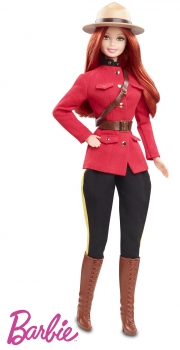“There is a Princess in every girl. To be a Princess is to always look your best.” – Barbie
According to the US CDC, the average 19 year old American female is 62.7 inches tall, weighs 138 lbs, has a 32 inch waist and a head circumference of 20 inches. By comparison, (at a 1:16 ratio), a “life-sized” Barbie would be 69 inches tall, weigh 110 lbs, have an 18 inch waist and a head circumference of 22 inches.

Recently, artist and University of Pittsburgh alumni, Nickolay Lamm, created a model of Barbie re-imagined as a “real” woman. © Nickolay Lamm, mydeals.com, http://www.mydeals.com/blog/what-if-barbie-looked-like-a-real-woman/post
Besides the gargantuan head, Barbie sports feet reminiscent of Tang Dynasty Imperial China, arms fashioned after an anorexic spider, and a neck that looks like an early prototype for the giraffe.
In fact, to actually attain Barbie’s mythic proportions, the average 19 year old female would need to gain over 6 inches in height and surgically remove her bottom ribs, her trapezii, half of her triceps, most of her forearms, her hamstrings, her calves, plus her glutei maximi. She would also need an ear reduction, a brow lift, a jaw line shave, a nose job, a neck reduction, a breast augmentation and a tummy tuck.
While fans laud the doll as a female-centered creative outlet for young girls , empirical research confirms that Barbie’s buxom proportions are not only unhealthy, they are biologically and statistically unattainable, with fewer than 1 in 100,000 women likely to be blessed cursed with her peculiar weight distribution (Ken’s physique, on the other hand, is a relatively common 1 in 50). But still they try, which is, perhaps, the point, because western females begin to internalize the cliché that “nothing tastes as good as skinny feels,” around the age of six, and research has consistently correlated Barbie with increased body dissatisfaction and eating disorders in young girls.
Whichever side of the debate you land on, however, there is little doubt that Barbie’s unrealistic and idealistic proportions epitomize men’s neurobiological evolutionary preference for low waist-to-hip ratio, smooth hairless skin, big eyes, pre-Raphaelite hair, and large pronounced breasts, all of which are signs of reproductive viability.
As do Maxim models.
As do Playboy Bunnies.
Mass media and iconic status are potent envoys of sociocultural ideals and in this sense, the power of Barbie far outweighs the impact of Maxim or Playboy because she is the stuff of legend, an iconoclastic ideal that undergirds our very concept of feminity—in the so-called First World, at least—through a never ending stream of movies, books, toys, housewares, clothing and costumes.
Well, that plus the fact that we market her to five year olds…
And this only makes the latest addition to Barbie’s Dolls of the World Series all the more discombobulating because when gender controversy collides with harassment scandal, it creates the Perfect Storm:
Ladies and Gentlemen, all the way from Canada, wearing “the ancestral clothing of her country,” put your hands together for RCMP Barbie...
What’s next? Sexual Harassment Ken?
Did anyone in Ottawa stop to consider the ramifications of packaging a Mountie in a manikin whose “life size” waist is the approximate circumference of Bob Paulson’s bicep, whose body weight is too low to support menstruation and who is endowed with enough flowing red hair to cover a yak?
Did I say yak?
I meant Buffalo.
Yes, I get it. Mattel is in this for the money (at the height of Barbie’s popularity, she sold at a rate of 120 dolls per minute, worldwide). But what is the Force’s motivation in marketing this product through The Mountie Shop, aka, the “official retailer of the RCMP,” and why would an organization previously billed as “Canada’s Finest,” charge—breasts first—into such a dubious political and ethical quagmire?
In a political climate that has seen the Mounties slapped with sexual harassment suit after sexual harassment suit, the Force needs to examine the cultural subtext inherent in its decision to publicly endorse the representation of Female Member as Fertility Goddess.
According to Dr. David Frederick, gender researcher and Assistant Professor of Psychology at Chapman University, California, there is a direct connection between seemingly benevolent female sexual stereotypes and overt, hostile sexism, which includes anything from “cat calling to job discrimination to date rape.”
Hmmm… now where have we seen those allegations before?
© copyright 2013 ingrid baier all rights reserved
References
Anschuntz, Doeschka J. & Rutger Engels. (2010) The Effects of Playing with Thin Dolls on Body Image and Food Intake in Young Girls. Springer Open Choice. November; 63(9-10)621
Dittmar, et al. (2006). Does Barbie Make Girls Want to Be Thin? The Effect of Experimental Exposure to Images of Dolls on the Body Image of 5- to 8-Year-Old Girls. Developmental Psychology Vol. 42, No. 2, 283–292
Gallup, G. G., Jr., & Frederick, D. A. (2010). The Science of Sex Appeal: An Evolutionary Perspective. Review of General Psychology, 14, 240-250. Retrieved August 16, 2013: https://docs.google.com/file/d/0B66b5mWS0F_3bWc1Nlp6S0lDVWc/edit?pli=1
Lever, Janet et al. (2013). Who Pays for Dates? Following versus Challenging Conventional Gender Norms. Retrieved August 16, 2013: http://www.scribd.com/doc/160036991/AM-2013-Frederick-Study
Pedersen, E. L., & Markee, N. L. (1991). Fashion dolls: Representations of ideals of beauty. Perceptual and Motor Skills, 73, 93–94.
Shea, Courtney. Why Dudes are Still Paying for Dates. The Globe & Mail, August 16, 2013.

